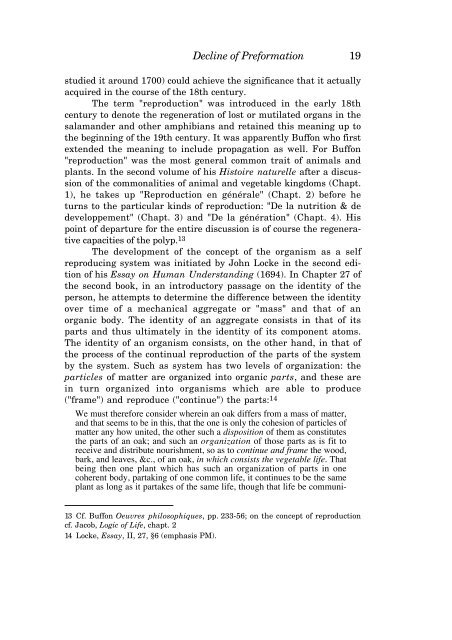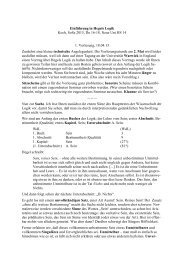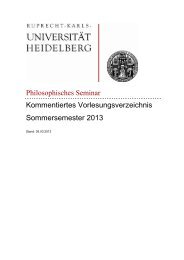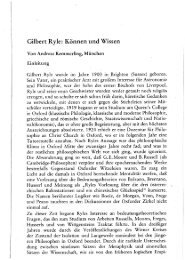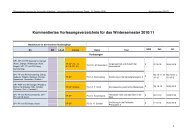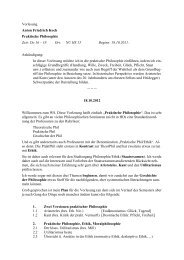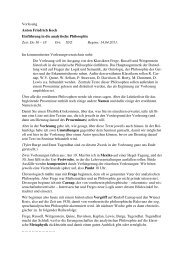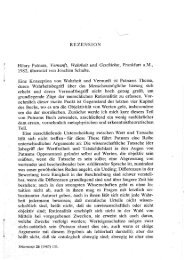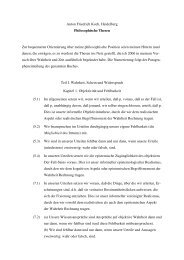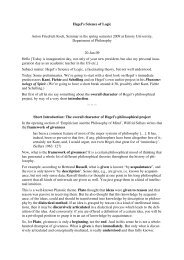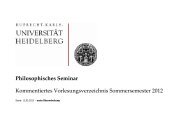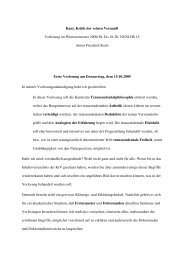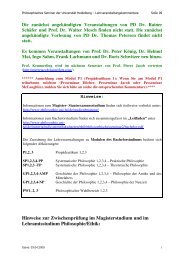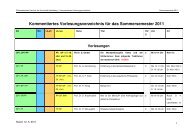KANT'S CRITIQUE OF TELEOLOGY IN BIOLOGICAL EXPLANATION
KANT'S CRITIQUE OF TELEOLOGY IN BIOLOGICAL EXPLANATION
KANT'S CRITIQUE OF TELEOLOGY IN BIOLOGICAL EXPLANATION
You also want an ePaper? Increase the reach of your titles
YUMPU automatically turns print PDFs into web optimized ePapers that Google loves.
Decline of Preformation 19<br />
studied it around 1700) could achieve the significance that it actually<br />
acquired in the course of the 18th century.<br />
The term "reproduction" was introduced in the early 18th<br />
century to denote the regeneration of lost or mutilated organs in the<br />
salamander and other amphibians and retained this meaning up to<br />
the beginning of the 19th century. It was apparently Buffon who first<br />
extended the meaning to include propagation as well. For Buffon<br />
"reproduction" was the most general common trait of animals and<br />
plants. In the second volume of his Histoire naturelle after a discussion<br />
of the commonalities of animal and vegetable kingdoms (Chapt.<br />
1), he takes up "Reproduction en générale" (Chapt. 2) before he<br />
turns to the particular kinds of reproduction: "De la nutrition & de<br />
developpement" (Chapt. 3) and "De la génération" (Chapt. 4). His<br />
point of departure for the entire discussion is of course the regenerative<br />
capacities of the polyp. 13<br />
The development of the concept of the organism as a self<br />
reproducing system was initiated by John Locke in the second edition<br />
of his Essay on Human Understanding (1694). In Chapter 27 of<br />
the second book, in an introductory passage on the identity of the<br />
person, he attempts to determine the difference between the identity<br />
over time of a mechanical aggregate or "mass" and that of an<br />
organic body. The identity of an aggregate consists in that of its<br />
parts and thus ultimately in the identity of its component atoms.<br />
The identity of an organism consists, on the other hand, in that of<br />
the process of the continual reproduction of the parts of the system<br />
by the system. Such as system has two levels of organization: the<br />
particles of matter are organized into organic parts, and these are<br />
in turn organized into organisms which are able to produce<br />
("frame") and reproduce ("continue") the parts: 14<br />
We must therefore consider wherein an oak differs from a mass of matter,<br />
and that seems to be in this, that the one is only the cohesion of particles of<br />
matter any how united, the other such a disposition of them as constitutes<br />
the parts of an oak; and such an organization of those parts as is fit to<br />
receive and distribute nourishment, so as to continue and frame the wood,<br />
bark, and leaves, &c., of an oak, in which consists the vegetable life. That<br />
being then one plant which has such an organization of parts in one<br />
coherent body, partaking of one common life, it continues to be the same<br />
plant as long as it partakes of the same life, though that life be communi-<br />
13 Cf. Buffon Oeuvres philosophiques, pp. 233-56; on the concept of reproduction<br />
cf. Jacob, Logic of Life, chapt. 2<br />
14 Locke, Essay, II, 27, §6 (emphasis PM).


